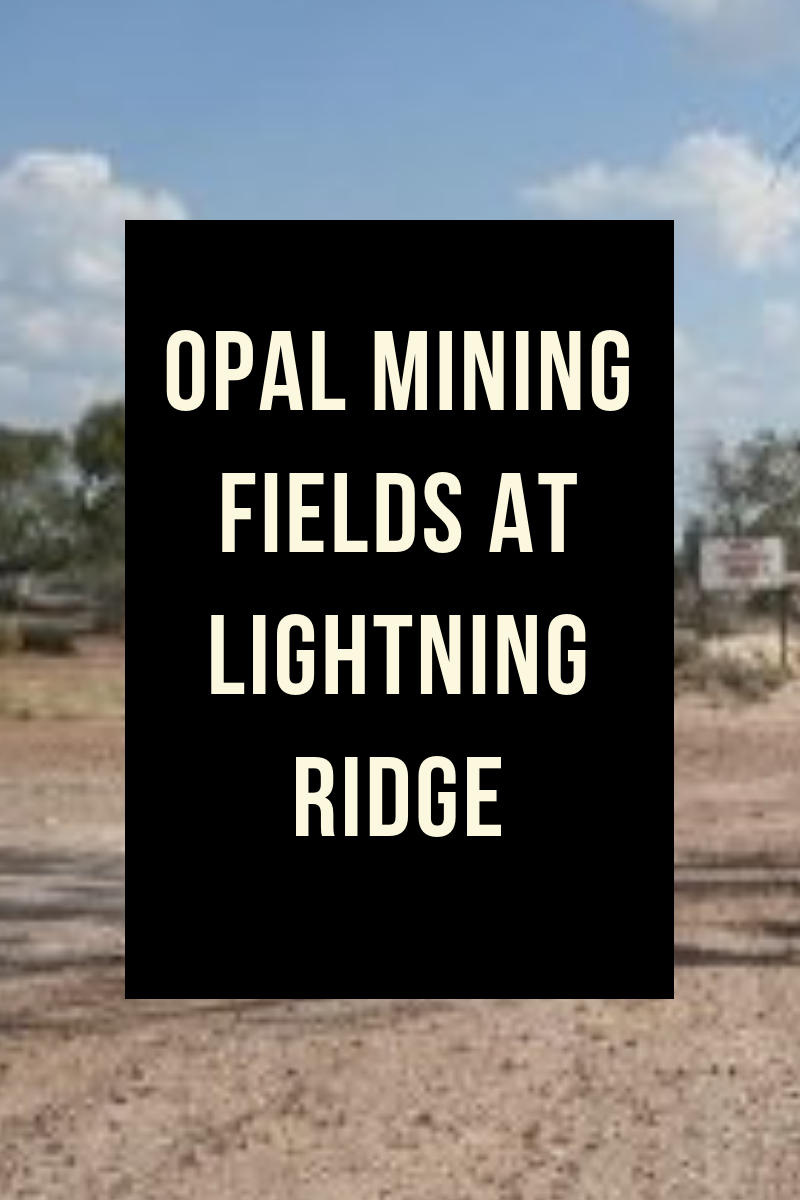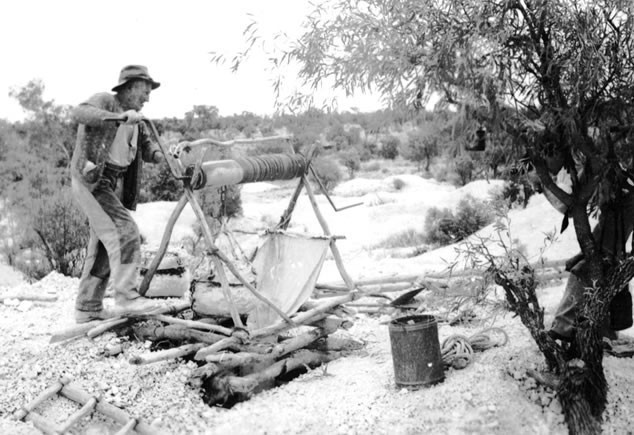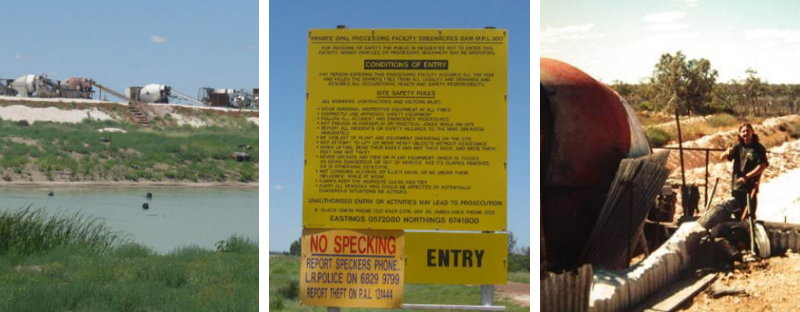
Pubblicato il 15th Nov 2018
Modificato il 17th Nov 2025
Campi minerari di opale a Lightning Ridge
 Lightning Ridge è la rinomata dimora dell'inafferrabile Opale Nero, che ha reso famosa questa piccola città mineraria. Molti credono che questa rara gemma sia il simbolo perfetto della città, poiché la natura esatta di Lightning Ridge e dei suoi abitanti rimane misteriosa quanto l'Opale Nero stesso.
Lightning Ridge è la rinomata dimora dell'inafferrabile Opale Nero, che ha reso famosa questa piccola città mineraria. Molti credono che questa rara gemma sia il simbolo perfetto della città, poiché la natura esatta di Lightning Ridge e dei suoi abitanti rimane misteriosa quanto l'Opale Nero stesso.
L'opale nero fu scoperto per la prima volta nel 1870, ma solo all'inizio del 1900 si diffuse la voce della scoperta di una nuova forma di opale nella zona. Molti minatori della vicina città di White Cliffs, nota per la sua attività estrattiva, intrapresero il viaggio di 700 km a piedi fino a Lightning Ridge, convinti che la loro fortuna fosse lì ad attenderli. Charlie Nettleton, da allora riconosciuto come uno dei principali promotori del settore, intraprese anch'egli il viaggio durante la siccità del 1902 e tornò a White Cliffs un anno dopo per sviluppare un mercato per l'opale nero.
L'attività mineraria si rivelò un lavoro incredibilmente duro tra la fine del 1800 e l'inizio del 1900, poiché i minatori usavano semplicemente picconi e pale per scavare pozzi squadrati, nei quali si arrampicavano con schiena e gambe precariamente appoggiate alle pareti. Oggi i minatori utilizzano scale d'acciaio e carrucole meccaniche nel sottosuolo per sollevare la terra in eccesso dalla miniera alla superficie.

Figura 1: Lightning Ridge, dimora dell'opale nero
Lightning Ridge ha avuto una storia tumultuosa, dalla formazione e successiva dissoluzione di sindacati, al sequestro dei minatori, all'avvelenamento dell'acqua potabile, fino a un'aspra lotta contro due grandi compagnie di pastori di Sydney, che possedevano gran parte del terreno e volevano impedire il successo dell'estrazione di opale nella zona. Tuttavia, è da questa storia turbolenta che Lightning Ridge si è sviluppata fino a diventare la fiorente città mineraria che è oggi.
QUANTO COSTA ESTRARRE L'OPALE?
Sono finiti i giorni in cui tutto ciò di cui un minatore aveva bisogno era una concessione di 20 dollari e un piccone e una pala per estrarre l'area. Oggi, per gestire una tipica miniera a cielo aperto è richiesto un deposito di oltre 250.000 dollari e almeno il doppio per gestire una miniera di opale a cielo aperto. Per questo motivo, è necessario unire diverse concessioni, il che si rivela spesso difficile.
Inoltre, le nuove normative impongono ai minatori di seguire un corso di estrazione di opale del valore di 2.000 dollari, che insegna loro il primo soccorso, i problemi elettrici e le procedure di sicurezza tecnica. I minatori devono inoltre presentare domanda di concessione per l'estrazione di opale al "Dipartimento dei Minerali" e rispettare rigorosi vincoli ambientali, che includono la ripiantumazione della vegetazione sul sito dopo la data di scadenza della concessione. Nel corso degli anni, il prezzo di questa concessione è aumentato da 435 dollari a ben 1.230 dollari. Nel 2013, ABC News ha pubblicato un articolo che descriveva dettagliatamente la dura realtà e i costi associati alla vita a Lightning Ridge come minatore, che potete leggere qui .
Non è facile per gli "esterni" acquistare e avviare una miniera di opale nella zona, poiché le miniere di opale in vendita sono rare e solitamente vendute all'interno della comunità. Molte delle migliori miniere di opale vengono acquistate con una quota di profitto, anziché essere vendute interamente. Ciò significa che il proprietario può comunque ricevere una percentuale di profitto dagli opali estratti dai lavoratori locali.
Anche la vita a Lightning Ridge ha un prezzo elevato. I lussi quotidiani sono rari e la benzina costa quasi il doppio rispetto a quella cittadina. Molti minatori hanno dovuto accettare un altro lavoro nelle miniere di carbone locali per assicurarsi un flusso di cassa costante. Eppure, anche se la vita di un minatore a Lightning Ridge può essere difficile, può anche rivelarsi gratificante, con molti minatori che tornano anno dopo anno.

PROSPEZIONE OPALE
"Prospezione" è il termine utilizzato per descrivere l'estrazione di opale. I potenziali minatori devono richiedere una "Licenza di Prospezione Opale" o una Licenza Mineraria prima di poter iniziare la prospezione. È importante che i potenziali minatori ricordino che la prospezione è ben diversa dall'attività mineraria.
Le licenze di prospezione sono consentite su aree più ampie e sono piuttosto facili da ottenere rispetto alle concessioni minerarie, che spesso richiedono il rilascio di cauzioni. Generalmente, vengono approvate annualmente dalle 50 alle 100 licenze di prospezione per l'opale. Nella riserva di Narran-Warrambool sono state definite quattro aree di prospezione, istituite per preservare la tradizione dei piccoli cercatori anziché continuare a concedere concessioni minerarie di grandi dimensioni. È importante notare che la prospezione non può essere effettuata nei parchi nazionali o nelle aree faunistiche.  Figura 2: Prospezione tradizionale dell'opale
Figura 2: Prospezione tradizionale dell'opale
METODI DI PROSPEZIONE DELL'OPALE
La prospezione di opali può essere un lavoro faticoso, con numerose trivellazioni e scavi in miniere sotterranee, sostenute da pozzi. Oggi, i cercatori possono estrarre gli opali in diversi modi:
Scavo di pozzi: prima dell'istituzione della perforatrice nel 1987, lo scavo di pozzi era il metodo più diffuso per la prospezione dei giacimenti di opale. Purtroppo, lo scavo manuale dei pozzi era costoso e richiedeva molto tempo.
Trivellazione a coclea: l'introduzione della trivella non solo accelerò il processo di estrazione, ma offrì anche una tecnica più economica per scavare pozzi. La trivella a coclea da 23 cm di diametro aiutò i minatori a testare la presenza di arenaria prima di scavare un pozzo, anziché lavorare alla cieca in un'area specifica.
Perforazione a percussione: la perforazione a percussione è simile alla perforazione con Auger, ma è molto più precisa perché crea fori più piccoli e di conseguenza rappresenta un modo più efficiente per trovare e testare i campioni.
Sirotem: Questa moderna tecnica di estrazione è di gran lunga il mezzo più efficiente per testare una vasta area di terreno. Utilizzando correnti elettriche per misurare la resistenza elettrica della roccia, i minatori possono individuare eventuali faglie o arenarie nell'area.

POPOLAZIONE DI LIGHTNING RIDGE
La popolazione di Lightning Ridge varia a seconda delle stagioni. Si stima che la popolazione sia di 1200 abitanti, a cui si aggiungono oltre 80.000 visitatori ogni anno. Per questo motivo, il cartello indicatore della popolazione sulla strada principale reca un punto interrogativo, a simboleggiare l'arguto umorismo della città.  Molte persone visitano Lightning Ridge nei mesi più freddi e se ne vanno in estate a causa del caldo estremo. Anche la gente del posto se ne va in questo periodo. L'inverno è il periodo migliore per i cercatori di opali per andare a "specking" nelle discariche, poiché la stagione delle piogge pulisce la terra e scopre le pagliuzze di opale. Tuttavia, i cercatori devono essere veloci, poiché i venti polverosi che seguono rendono sempre più difficile scoprire questi tesori dimenticati. È interessante notare che i cercatori di opali non hanno bisogno di un permesso per recarsi nei campi dei minatori o nelle discariche e spesso possono avere una fortunata scoperta di opali.
Molte persone visitano Lightning Ridge nei mesi più freddi e se ne vanno in estate a causa del caldo estremo. Anche la gente del posto se ne va in questo periodo. L'inverno è il periodo migliore per i cercatori di opali per andare a "specking" nelle discariche, poiché la stagione delle piogge pulisce la terra e scopre le pagliuzze di opale. Tuttavia, i cercatori devono essere veloci, poiché i venti polverosi che seguono rendono sempre più difficile scoprire questi tesori dimenticati. È interessante notare che i cercatori di opali non hanno bisogno di un permesso per recarsi nei campi dei minatori o nelle discariche e spesso possono avere una fortunata scoperta di opali.
CAMPI MINERARI DI OPALE A LIGHTNING RIDGE
Ci sono oltre 200 giacimenti di opale a Lightning Ridge, tuttavia i giacimenti più popolari sono elencati di seguito:
- Bald Hill: una delle poche miniere "walk-in" di Lightning Ridge; la maggior parte del prezioso opale trovato in questa zona è stata recuperata dalle miniere principali, su un'area di soli 120 metri per 30 metri! I visitatori possono visitare la miniera tutti i giorni dalle 9:00 alle 17:00 con tour autoguidati o tour in pullman.
- Deep-Four Mile: negli anni '30, i minatori estraevano opale di buona qualità da cinque concessioni a Deep-Four Mile, con il pozzo più profondo che si estendeva per oltre 28,5 metri.
- Hawks Nest: lo sprofondamento in questo sito variava da 1,2 metri a 12 metri, con lenti spesse fino a 2,7 metri ancora presenti, che producono opale prezioso di buona qualità. In alcuni pozzi sono state intersecate tre lenti con opale a 3,6 metri, 6,9 metri e 12 metri.
- Nebea Hill: scoperta nel 1973, questa miniera è considerata una delle più produttive della zona. Si stima che otto concessioni abbiano prodotto opale per un valore di oltre 3.000.000 di dollari in due anni. Le tecniche di estrazione utilizzate in loco nel corso degli anni sono iniziate con l'estrazione a cielo aperto su larga scala, seguita dall'estrazione sotterranea.
- New Chum e Old Chum: una pietra di opale da 100 carati è stata recuperata nell'area di New Chum di questo sito, mentre un galleggiante di opale è stato trovato nella ghiaia sul fianco della collina nell'area di Old Chum.
- New Rush (New Nobby): estratto negli anni '60 con una profondità massima del pozzo di 12 metri, questo sito ha restituito il prezioso opale, che ha provocato una corsa all'estrazione nella zona e l'affondamento di circa 100 pozzi.
- Nine Mile: uno dei giacimenti più sfruttati, ancora oggi in attività, con pozzi profondi fino a 12 metri sulla cresta della collina. In questa zona è stato rinvenuto del Potch, intervallato da Opal.
- Rouses-Six Mile: l'ubicazione esatta di quest'area è incerta; tuttavia, si sa che è vicina al McDonald's Six Mile. Solo due concessioni hanno prodotto quantità significative di Opale in quest'area e gran parte dell'Opale era sotto forma di grossi Black Nobbies.
- Shallow Belars: come suggerisce il nome, questo campo è piuttosto poco profondo, con una profondità compresa tra 0,3 e 3,6 metri. In questo sito sono stati recuperati opali di buona qualità, costituiti da bivalvi opalizzati.
- The Old Nobby: uno dei primi pozzi nel giacimento di Lightning Ridge fu scavato a Nobbys e l'opale fu inizialmente trovato nella ghiaia ai piedi della cresta. Sebbene le rocce siano estremamente dure e difficili da lavorare, una quantità considerevole di opale è stata recuperata da una profondità di 6 metri.
- Three Mile: una delle miniere più famose e sfruttate, questo giacimento ha raggiunto il picco con oltre 1.000 persone impegnate nell'estrazione di opale contemporaneamente. Di gran lunga una delle aree più produttive del giacimento, negli ultimi anni è stata avviata un'estrazione a cielo aperto su larga scala.
- The Six Mile: noto anche come McDonald's Six Mile, la profondità della facies argillosa di Finch varia dai 9 ai 12 metri sulla cresta della collina e 1,8 metri alla base della collina, con l'opale migliore che si trova più in profondità nel terreno.
- Six Mile di Thorley: questo giacimento fu sfruttato per la prima volta nel 1902 da una profondità compresa tra 6 e 12 metri e poi riscoperto dai minatori negli anni '70, poiché il giacimento continua a produrre opale nero di alta qualità.
ACQUISTA PIETRE DI OPALE DI CRISTALLO LIGHTNING RIDGE
Cerca il Opal Encyclopedia
Aste correlate
articoli Correlati
Tabella di conversione per le misure degli anelli
17th Jul 2018
L'opale Boulder è uno degli opali più sottovalutati sul mercato. Scopri di più su questo opale unico e scopri le splendide pietre che abbiamo in vendita.
29th May 2019
Con la passione per gli opali, Wayne ed Estella Sedawie hanno fondato Opal Plus più di 14 anni fa e hanno scoperto che internet è uno strumento prezioso. È qui che avviene la maggior parte delle transazioni internazionali dell'azienda.
17th Oct 2018
Articoli Recenti
Gli opali neri sono la varietà di opale più ricercata, con basi profonde che conferiscono un arcobaleno di riflessi alla superficie. Scopri gli usi, le proprietà, la storia e il valore degli opali neri!
7th Dec 2025
Scopri come vengono classificati gli opali e quali fattori ne influenzano il prezzo. Dal colore alla brillantezza, dal taglio all'origine, scopri come viene valutato ogni tipo di opale, con esempi di fasce di prezzo.
19th Jul 2023
Venite a scoprire il potere curativo degli opali con la nostra scrittrice ospite Vivien Schapera di Crystal Healing Techniques!
20th May 2023
Categorie di articoli
All there is to know about Opals including Black Opals, Ethiopian Opals & Boulder Opal
14 Articoli
Check out our fascinating information and articles on all things amazing in the Opal world
41 Articoli
Opal Auctions sellers who are approved as opal Verified Sellers
4 Articoli





